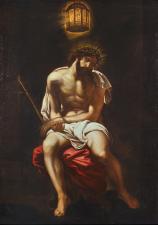Christ Mocked
The Expertise
The painting portraying “Christ Mocked” is a work of the Italian period of the painter Pieter Paul Rubens.
The work at issue fits the context of the period he spent in Italy at the service of the Gonzaga Family of Mantua between 1600 and 1606. But more precisely, this masterpiece can be connected with an important commission of such period, the Chapel of St. Helen in the Roman Church of Santa Croce in Gerusalemme. The cycle, today dismembered, was requested in 1601 by the Archduke Albert of Habsburg, governor of the Netherlands. His representative in Rome was Jean Richardot. The first altarpiece had to depict St. Helen and, at the present day, it is in the Cathedral Museum in Grasse.
In 1602, again on behalf of the above mentioned Archduke (who had been titular of Santa Croce), Richardot commissioned to Rubens the second painting for the altar facing the previous one, portraying a “Christ Mocked” (this today is also housed in the Cathedral Museum in Grasse), while the third altarpiece depicting “The Elevation of the Cross” is today lost and replaced by a copy on a wooden panel.
The three compositions, originally on arch-shaped wooden panels, underwent severe damages due to damp infiltrations in the Chapel. For such reason, they were moved several times inside the convent until they were sold to a British art-dealer at the beginning of the 19th century, and finally at the Squibb’s Sale in London in 1811.
Of the cycle several preparatory studies by Rubens are known, today belonging to various international collections.
The painting “sub judice” possesses significant variations from the final version on wood in which are also comprised several secondary figures.
The formal solutions attest the linguistic concerns of the young artist, who modelled from the so called “Belvedere Torso”, a fragmentary statue of Lysippos belonging to the Vatican collections, and solves the complicated chiaroscuro deriving from the artificial lighting (note the lamp and the relative projections on the figure and on the floor) that he had studied in the Venetian environment of Titian and Tintoretto but that in those Roman years he revised in accordance to the naturalistic and dramatic avantgarde of Caravaggio (Rubens must have known “The Crowning of Thorns” painted by Caravaggio in 1601-02 for Massimo Massimi).
In conclusion, I believe that this study remained property of the artist himself as an “exemplum” of the important Roman commission. (Maurizio Marini)







